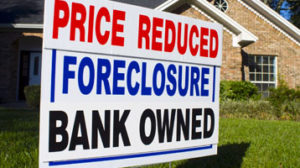 Now that you know how to get free Pre-foreclosure, Short Sale, Foreclosure, and REO leads, I want to show you the nine different types of Foreclosure Deals and how they all fit together.
Now that you know how to get free Pre-foreclosure, Short Sale, Foreclosure, and REO leads, I want to show you the nine different types of Foreclosure Deals and how they all fit together.
This is something that not one investor in 100 or 1000 understands, and this is why they just don’t get the results they want.
It’s also why most investors are happy to do the most difficult, least valuable types of deals, and leave the “cherry on top” deals for those of us who have taken the time to really “get” what I’m about to show you.
Because they have only learned one or maybe two of the nine different strategies, it leaves them squabbling over the worst deals, with the most competition.
Here’s how to make sure it doesn’t happen to you:
The first strategy is clear and obvious. If you can get in touch with a seller who is in Preforeclosure, and they have plenty of equity, and they can sell their house cheap, then that’s an easy, cheap, Foreclosure deal.
Now, some of them owe too much to sell cheap, some of them don’t.
Some of them don’t owe all that much at all, but they don’t seem very motivated.
I understand.
What I am telling you is that the first and easiest strategy most people use is to simply deal only with the properties that have enough equity for you to make a profit.
That allows you to just simply control the property, turn around and sell it either to an investor buyer if it is a rehab, or an owner occupant buyer if it is a pretty house for a profit.
This is straightforward. It is all just a matter of finding those leads in your area, and what message and marketing to use to get them to respond to you.
By the way, that is what 90% of the world believes is the entire Foreclosure business, the handful of deals that come down the pike that have
equity and you can buy them cheap.
There aren’t many of these deals, they are the LEAST Motivated of all foreclosure Sellers, and LOTS of people are looking for them.
And because of that, there is 10 – 20 TIMES more competition for these deals, and it can be tough to get to the great deals before someone else does.
But that’s just the first way.
The next way that you can expand the number of deals that you do is by buying Foreclosure properties “Subject-to” the existing financing.
That’s when the Seller sells the house to you, and the loan stays attached to the property and in the seller’s name, instead of being paid off and replaced by a new loan.
It’s great because there’s no need for banks, or lenders or partners because the deals require NO Financing!
The seller can deed you the house, and the loan is going to stay in their name, and you are going to reinstate those back payments, bring it current, and sell it however you like – long term or short – for a nice profit.
Now I understand some of you just gasped and moaned and said, “Somebody told me not to do that anymore or is that legal? or blah, blah, blah.”
It’s legal, moral, and ethical in every way, and when you do it right, you are saving a Seller, saving a bank, heck, saving an entire neighborhood from a big problem.
When you take over those properties, it is a wonderful way to massively expand the number of deals you can do and extend your leverage since it doesn’t require financing, it doesn’t require time, effort, energy on your part above and beyond finding the great deals.
Once you understand it and know how to do it properly, I promise you it will triple or quadruple the number of deals you can do.
So getting the deed and reinstating that loan will massively increase your profitability and your number of deals.
Now, over the last few years, because of all the mix-ups in the Financial Industry and banking, the banks have gotten very, very willing to do what I call a “Loan Modification”.
That means let’s say the seller owes—and I am just going to make up a number so if you are in California when I say this number you are going to laugh and if you are in the Ozarks in Arkansas you are going to say, “How many acres does it have?” okay…
But let’s say we are dealing with a nice single family home which, in much of the U.S., which is around $250,000.
So let’s say that we are dealing with a pretty house in a good neighborhood with average nearby sales of around $250k.
Now imagine you have a seller that owes $210,000 and they have $8000 in back payments.
Well, banks nowadays will almost always allow you to either:
A) Make up that $8000 in back payments in installments, meaning something like an extra $200 a month for the next 40 months or they will…
B) Take that $210,000, they will add the $8,000 in back payments to it, for $218,000 total and they’ll do what is called a Loan Modification or a “Loan Recast” where they will take that $218,000 and make a new 30 year mortgage.
So if the Seller had already paid on their mortgage for 2 years, and had 28 years left, the Bank will re-stretch it back out to 30 years, so the payment stays roughly the same and in addition to that the loan is brought current without you having to pay $8000.
C) The other thing that they might do is take the $8000 and say, “Well, that $8000 would be eight payments of $1000 so we are going to extend the monthly payment by eight payments, so now instead of 28 years left you have 28 years and eight months left.”
Different Banks have different names for that. Some call it a loan modification and some call it a streamline. Some call it recasting.
Whatever they call it, it is the same process.
It is a structured repayment of the back payments that allows you to get into the property with absolutely no money out of your pocket and bring it current without having to pay the back payments.
What does this mean?
This means you own the house, with long term, low interest Owner Occupant financing. So you can sell it however you want- short term flip, long term keeper, your choice.
You have plenty of time because it is not in Foreclosure anymore because the bank brought it current.
The bank brought it current basically themselves, as long as it’s repaid by the repayment schedule.
And of course, when you sell it, long term or short term, it’s paid in full and everyone wins.
Here’s a tip:
You can Lease Purchase these properties out to worthy families, and keep the whole deposit as up front profit.
Then use the Lease Option Buyer’s monthly payments to pay the bank until they buy it and it gets paid off and you get a BIG check at closing. Or, if they change their minds and don’t buy it, you keep the entire deposit as a profit, and turn around and sell it to someone else.
So let’s say you have got the same $210,000 house with $8000 in back payments and they decide to turn that into a $218,000 loan for eight months longer than the original loan.
Well, your payment didn’t change and you don’t have to put the $8000 into the arrearages to bring it current. So when your lease option tenant on the $250,000 house comes along and gives you a six or seven or $8000 up front deposit, you get to keep the whole six or seven or $8000 rather than having to pay it to the bank to reinstate.
And when you do something like a loan modification or a streamline or whatever that Bank calls it, it gives you the ability to do deals that not one investor in 1000 knows exists because they are all saying, “Well, I don’t want to put that much money into the deal.”
Well, we are not putting money into the deal.
But don’t tell your so-called competition this, because it expands our ability to do these deals by double or triple or quadruple, and they are clueless!
So if finding, controlling, and flipping these deals without using your own money or credit, and without being on the hook for monthly payments or giving up profits for money partners or lenders sounds good to you, and you’re thinking, “This makes so much sense- now I understand why some Investors get all the deals and others are getting desperate and fight over the scraps,” then you might be wondering how you can implement all the tactics and strategies I just showed you …quickly and easily.



